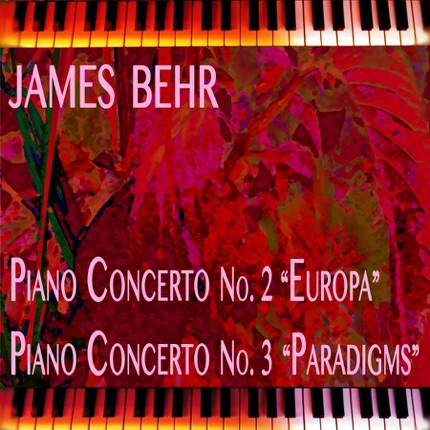

PIANO CONCERTO No. 2 "EUROPA"
PIANO CONCERTO No. 3 in D minor "PARADIGMS"
GEM Studio Orchestra • James Behr, , PIANO
Conductors: Recordings available upon request.
PROGRAM NOTES: PIANO CONCERTO NO. 3 "PARADIGMS"
1. Allegro: "Classically"
2. Andante: "A Distant Past"
3. Vivace: "Traditions"
Behr's third piano concerto, completed in 2016, is named Paradigms for good reason. The Oxford American Dictionary defines paradigms as “An example or model of how things should be done." This fits Behr's musical philosophy: melodic yet contemporary, in a word, modern romanticism. He rejects intense atonality of modern composers, instead emphasizing balance: melody alongside modernism, phase music, light atonality, and multiculturalism from folksy/jazzy American to Turkish to Russian to Spanish music. Behr presents a unique phase style all his own. The kaleidoscopic feel of his music is unlike anything heard before: fresh, original and modern yet a salute to that which makes Romantic music so beloved. Each movement reflects traditions from which Paradigms finds inspiration. Behr, a product of classical training (he's a Juilliard graduate with a B.M. & M.M.), admires atonality from Stravinsky to Schoenberg, but believes a return to romanticism in the Classical world is long overdue. The need to reach new audiences with accessible new music is important.
1. Classically • The first movement, Classically, follows sonata-allegro form, excepting a lovely melodic passage ending the development. A glorious coda foreshadows the second movement. Classically is at times dark, playful and lushly melodic. It is ever-changing and wonderfully unpredictable.
2. A Distant Past • The second movement, A Distant Past, following ternary form, opens with a nod to Medieval Europe as double bass clumsily recite a Gregorian Chant-like melody repeated by woodwinds with Renaissance-like feel. A contrapuntal piano solo of churchlike feel follows, abruptly launching into jazz-like riffs and delicious melody. Afterward comes rhythmically punctuated Spanish-style development then a piano cadenza, dark, brooding, modern. The Jewish Hatikva briefly appears, an acknowledgement to a distant past that cannot overlook the contributions and tragic persecution of the Jewish people. The movement concludes with the opening chant and lush “B” melody, but with ominous overtones reflecting troubled present times of violence, terrorism and threat of rising oceans.
3. Traditions • The finale, Traditions, follows rondo form. Spicily multicultural, whimsical and charming passages flow into a lyrical piano solo then atonality. Recapitulation returns the playful “A” section flowing into a five-part fugue, a nod to the Baroque giant J.S. Bach. The concerto concludes with a pulsating, thrilling coda.
© Paradigms by James Behr. All rights reserved.
PROGRAM NOTES: PIANO CONCERTO NO. 2 "EUROPA"
1. "Traveler"
2. "Reminders
3. "Elegy"
4. "Homage"
5. "Fugue"
6. "To The East
Behr composed Europa following visits to Europe. The six movements of this piano concerto/suite reflect the kaleidoscopic European cultures and impressions of wandering throughout the charming but historically complex cities. Below is a description of each movement in the composer’s own words.
1. TRAVELER (Allegro, 8:45) Traveler conveys the thrill of arriving in European cities. The jubilant introduction slides into a rhythmic first theme followed by a warmly romantic second theme. The melodic idee fixe appears in colorful thematic transformation throughout the concerto. Traveler follows a modified sonata-allegro format with development in Homage and recapitulation in the finalé.
2. REMINDERS (Largo, 9:39) One sees disturbing reminders of the past throughout Europe, be it nearby concentration camps or Jewish synagogues turned-museum in neighborhoods where Jews once lived. Reminders depicts a chilling visit to Dachau, the concentration camp outside Munich – a reminder to those who prefer to rewrite history. The Dachau visit is musically told through the perspective of a child, a lonely flute impending doom as sickness plagues Europe in the 1940's. At the end, the piano (in a cadenza) plays the haunting melodies of the now silent flute – the child lives no more. Over a million such children perished... facts written out of history by some. The new enemy.
3. ELEGY (Andante, 3:47) Elegy was borne of a visit to Sarajevo, site of the 1914 assassination of Archduke Ferdinand, heir to the Austrio-Hungarian crown, triggering World War I. The street corner where the infamous murder occurred is largely unchanged. Just standing there brings on a chilling moment of reflection about the tragedy, the war that followed, and the eight million soldiers who died in a war often overlooked by the modern world. Their memories are left to museums and sepia photos... as are the million children who died in the holocaust... and the millions more who died. They must be protected from those trying to erase them from history.
4. HOMAGE (Moderato, 6:19) Homage opens pensively, reflecting visits to Berlin, Dresden and Warsaw, where ominous reminders of World War II and the cold war are evident as one roams the streets of the handsome, modern cities barely resembling those leveled by allied bombing, symbolized by the remnants of the Berlin Wall and the Warsaw Ghetto. Homage, stylistically, is also a nod to the great composers and the remarkable cities where they lived: Bonn/Vienna (Beethoven); Leipzig (Bach, Mendelssohn and Schumann); and Warsaw/Paris (Chopin).
5. FUGUE (Allegretto, 7:51) Fugue, inspired by a visit to Leipzig, home city of Bach and St. Thomas Church, where the master composed, is an homage to the great Baroque composer of counterpoint. Midway through you can hear the American folk song “Dixie” and envision the Yankee fellow roaming the streets of Eastern Europe in the heat of August. Fugue ominously transitions to the brisk finalé.
6. TO THE EAST (Allegro con brio, 8:17) The finalé depicts the bubbly travel through Slavic Eastern Europe and the cities of the former Austria-Hungary empire: Prague, Cracow, Bratislava, Vienna. Themes from the first movement recapitulate with Hungarian bravado. A haunting reprise of the second theme is followed by a coda sweeping the concerto to a conclusion, a salute to departing from the glorious European cities and flying to New York, America’s greatest city, and seeing from high up skyscrapers and the Statue of Liberty -- the New World borne from the Old.
© Europa by James Behr. All Rights Reserved.
